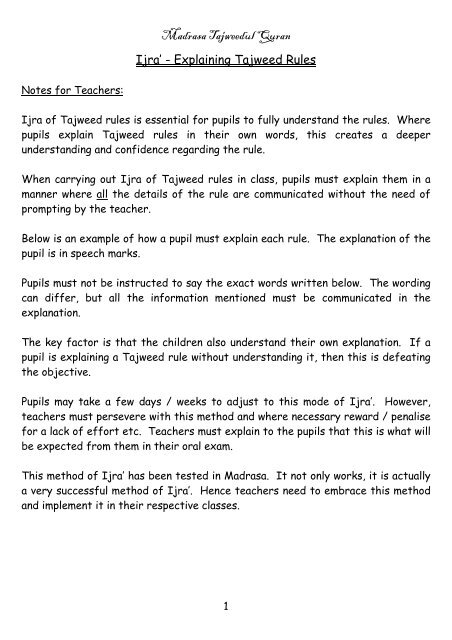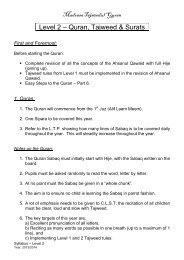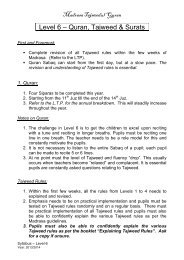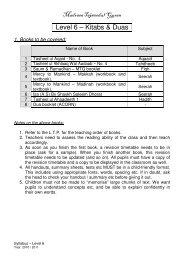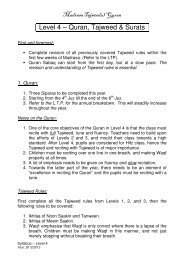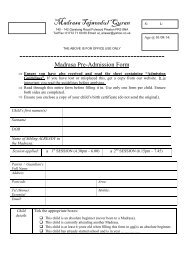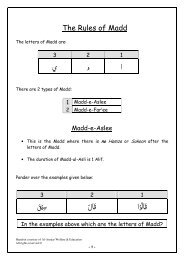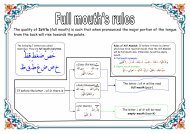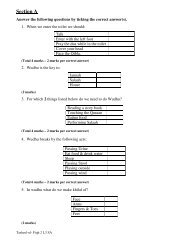Madrasa Tajweedul Quran
Explaining Tajweed Rules
Explaining Tajweed Rules
- No tags were found...
Create successful ePaper yourself
Turn your PDF publications into a flip-book with our unique Google optimized e-Paper software.
<strong>Madrasa</strong> <strong>Tajweedul</strong> <strong>Quran</strong><br />
Ijra’ - Explaining Tajweed Rules<br />
Notes for Teachers:<br />
Ijra of Tajweed rules is essential for pupils to fully understand the rules. Where<br />
pupils explain Tajweed rules in their own words, this creates a deeper<br />
understanding and confidence regarding the rule.<br />
When carrying out Ijra of Tajweed rules in class, pupils must explain them in a<br />
manner where all the details of the rule are communicated without the need of<br />
prompting by the teacher.<br />
Below is an example of how a pupil must explain each rule. The explanation of the<br />
pupil is in speech marks.<br />
Pupils must not be instructed to say the exact words written below. The wording<br />
can differ, but all the information mentioned must be communicated in the<br />
explanation.<br />
The key factor is that the children also understand their own explanation. If a<br />
pupil is explaining a Tajweed rule without understanding it, then this is defeating<br />
the objective.<br />
Pupils may take a few days / weeks to adjust to this mode of Ijra’. However,<br />
teachers must persevere with this method and where necessary reward / penalise<br />
for a lack of effort etc. Teachers must explain to the pupils that this is what will<br />
be expected from them in their oral exam.<br />
This method of Ijra’ has been tested in <strong>Madrasa</strong>. It not only works, it is actually<br />
a very successful method of Ijra’. Hence teachers need to embrace this method<br />
and implement it in their respective classes.<br />
1
1. Full Mouth Letters:<br />
<strong>Madrasa</strong> <strong>Tajweedul</strong> <strong>Quran</strong><br />
ظَ ل َمُ وْا<br />
ظ is a full mouth letter. The full mouth letters are: "<br />
خ ص ض غ ط ق ظ<br />
خُ صَّ<br />
ضَ غ َ ٍط<br />
قِظ<br />
2. Ghunnah:<br />
جَنَّةٌ<br />
“Ghunnah will happen here as there is Noon Mushaddad. Ghunna also happens<br />
when there is Meem Mushaddad. Ghunnah means to make a strong / heavy sound<br />
from the nose.”<br />
3. Throat Letters:<br />
غَاونَ<br />
غ is a throat letter. The throat letters are: "<br />
ء ع ح غ خ<br />
4. Allah Rule:<br />
بِاِذْنِ االلهِ<br />
“The (Laam of) Allah will be read empty mouth because the letter before it has<br />
got a Kasra. If the letter before the (Laam of) Allah has a Fatha or Dhamma,<br />
then (the Laam of) Allah would be read full mouth.”<br />
2
ُ<br />
<strong>Madrasa</strong> <strong>Tajweedul</strong> <strong>Quran</strong><br />
5. Qalqalah:<br />
وَ اَبْصَ ارِ هِ مْ<br />
“There will be Qalqalah on the بْ as it is one of the Qalqalah letters.<br />
Qalqalah letters are:<br />
ق ط ب ج د<br />
The<br />
قُطُ ب جَدٍّ<br />
Qalqalah will only happen if there is a Sukoon on a Qalqalah letter.”<br />
¤<br />
وَ تَبَّ<br />
“When a Waqf is made on a Qalqalah letter with “Tashdeed” i.e a Mushaddad<br />
Qalqalah letter, there will be a strong Qalqalah.” (Please see someone if you are<br />
unsure.)<br />
6. Madd:<br />
اَن ْ تُ ْم ماَۤ<br />
“Short / small Madd will happen here. We stretch for 3 seconds. For Big / long<br />
Madd, we stretch for 4 seconds. Madd means to stretch.<br />
Note: Pupils should be able to demonstrate the stretching by opening and closing<br />
the finger. Closing finger is one second and opening it is another second etc.<br />
7. Basic Raa:<br />
رُ سُ لٌ<br />
“The Raa will be read full mouth because it has a Dhamma. If it had a Fatha it<br />
would also be full mouth. If it had a Kasra, it would be read empty mouth.”<br />
3
8. Raa Saakin:<br />
<strong>Madrasa</strong> <strong>Tajweedul</strong> <strong>Quran</strong><br />
ي َغْفِرْ ل َكُمْ<br />
“The Raa Saakin will be read empty mouth because the letter before it has a<br />
Kasra. If the letter before had a Fatha or Dhamma it would be full mouth.”<br />
Note: The pupil must use the term Raa Saakin in the answer.<br />
قَدِ يْرٌ <br />
“The Raa Saakin will be read empty mouth because we are stopping on the Raa and<br />
the letter before it is a يْ (Yaa Saakin).<br />
9. Raa Mushaddad:<br />
مِنْ ّ رِ زْقٍ<br />
“The Raa Mushaddad will be read empty mouth ‘twice’ because it has a Kasra. If it<br />
had a Fatha or Dhamma, it would be full mouth ‘twice’.”<br />
Note: The pupil must use the term Raa Mushaddad in the answer and make<br />
reference to two Raa (twice).<br />
10. Waqf on a Mushaddad:<br />
فَطَ لٌّ<br />
“When doing Waqf on any Mushaddad letter other than Qalqalah letters, the<br />
sound of that letter will be prolonged.”<br />
Note: There should be no Qalqalah on that letter.<br />
4
11. Yoomin Ghunnah:<br />
<strong>Madrasa</strong> <strong>Tajweedul</strong> <strong>Quran</strong><br />
ْلاً<br />
بُكْرَ ةً وَّ اَصِ ي<br />
“If after Noon Saakin or Tanween there are one of the “Yoomin” letters, Yoomin<br />
Ghunna will be done. In this example, after Tanween there is a “Wow” from the<br />
Yoomin letters. Ghunna is to make a “strong / heavy” sound from the nose.<br />
Note: The pupil must refer to “strong / heavy” sound in the answer.<br />
12. Noon Saakin & Tanween Ikhfa:<br />
شَيْ ءٍ<br />
مِنْ<br />
“If after Noon Saakin or Tanween there are one of the following 13 letters, Noon<br />
Saakin & Tanween Ikhfaa will not be done.<br />
ء ع ح غ خ ل ر ب ي و م ن<br />
In this example, after Noon Saakin there is “Sheen”, which is not one of the 13<br />
letters, so Ikhfaa will be done. Ikhfaa is to make a “light” sound from the nose.”<br />
13. Meem Saakin Ikhfa:<br />
بِ ٖه ک َافِرٍ ۢ<br />
“After Meem Saakin there is a “Baa”, so Meem Saakin Ikhfa will be done. In<br />
Meem Saakin Ikhfa, we 1) Gently touch the lips and 2) Make a light sound from<br />
the nose.”<br />
5


